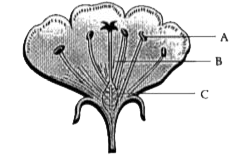Describe the structure of a flower.
Step-by-Step Solution for Describing the Structure of a Flower
1. Definition of a Flower:
- A flower is an organ in the body of a plant that is primarily responsible for reproduction. It plays a crucial role in sexual reproduction.
2. Basic Structure:
- The flower is typically attached to a stalk-like structure known as the thalamus. The thalamus is slightly swollen at the top and is usually green in color.
3. Female Reproductive Part:
- The female reproductive part of the flower is located on the thalamus. It consists of:
- Ovary: The lower, swollen part that contains ovules.
- Style: The tubular structure that connects the ovary to the stigma.
- Stigma: The platform at the top where pollen grains land.
4. Male Reproductive Part:
- The male reproductive part arises from the base of the ovary and consists of:
- Filament: A projection that supports the anther.
- Anther: The fertile part where pollen grains are produced.
5. Petals:
- Surrounding the reproductive parts are colorful leaves known as petals. The petals serve to attract insects for pollination, making the flower visually appealing.
6. Additional Structures:
- The collective term for all the petals is called the corolla.
- The outermost green leaves that protect the flower before it blooms are called sepals. The collective term for sepals is referred to as the calyx.
Summary of Flower Structure:
- Thalamus: Stalk-like structure.
- Ovary: Female reproductive part containing ovules.
- Style: Connects ovary to stigma.
- Stigma: Pollen landing platform.
- Filament: Supports the anther.
- Anther: Produces pollen grains.
- Petals: Colorful leaves for attracting pollinators.
- Corolla: All petals collectively.
- Sepals: Protective green leaves, collectively called calyx.
---
- A flower is an organ in the body of a plant that is primarily responsible for reproduction. It plays a crucial role in sexual reproduction.
- The flower is typically attached to a stalk-like structure known as the thalamus. The thalamus is slightly swollen at the top and is usually green in color.
- The female reproductive part of the flower is located on the thalamus. It consists of:
- Ovary: The lower, swollen part that contains ovules.
- Style: The tubular structure that connects the ovary to the stigma.
- Stigma: The platform at the top where pollen grains land.
- The male reproductive part arises from the base of the ovary and consists of:
- Filament: A projection that supports the anther.
- Anther: The fertile part where pollen grains are produced.
- Surrounding the reproductive parts are colorful leaves known as petals. The petals serve to attract insects for pollination, making the flower visually appealing.
- The collective term for all the petals is called the corolla.
- The outermost green leaves that protect the flower before it blooms are called sepals. The collective term for sepals is referred to as the calyx.
- Thalamus: Stalk-like structure.
- Ovary: Female reproductive part containing ovules.
- Style: Connects ovary to stigma.
- Stigma: Pollen landing platform.
- Filament: Supports the anther.
- Anther: Produces pollen grains.
- Petals: Colorful leaves for attracting pollinators.
- Corolla: All petals collectively.
- Sepals: Protective green leaves, collectively called calyx.
Topper's Solved these Questions
- HOW DO ORGANISMS REPRODUCE?BOOK - MBD -HARYANA BOARDCHAPTER - HOW DO ORGANISMS REPRODUCE?EXERCISE - EXAMPLE
185 Videos
- HOW DO ORGANISMS REPRODUCE?BOOK - MBD -HARYANA BOARDCHAPTER - HOW DO ORGANISMS REPRODUCE?EXERCISE - Short Answer Type Questions
28 Videos
- HEREDITY AND EVOLUTIONBOOK - MBD -HARYANA BOARDCHAPTER - HEREDITY AND EVOLUTIONEXERCISE - EXAMPLE
144 Videos
- LIFE PRCOCESS (NUTRIENT, RESPIRATION, TRANSPIRATION AND EXCERTIONBOOK - MBD -HARYANA BOARDCHAPTER - LIFE PRCOCESS (NUTRIENT, RESPIRATION, TRANSPIRATION AND EXCERTIONEXERCISE - EXAMPLE
183 Videos
Similar Questions
Describe the structure of ATP.
View SolutionDescribe the structure and function of ATP.
View SolutionDescribe the structure of forebrain of humans.
View SolutionDescribe the structure of a nerve cell.
View SolutionDescribe the structure of a pollen grain.
View SolutionDescribe the structure of a pollen grain.
View SolutionThe given diagram represent the structure of a flower. Study the structure

The labels A, B and C are
View SolutionDescribe the structure of diamond
View SolutionDescribe the structure of a tooth.
View SolutionDescribe the structure of operon.
View Solution
